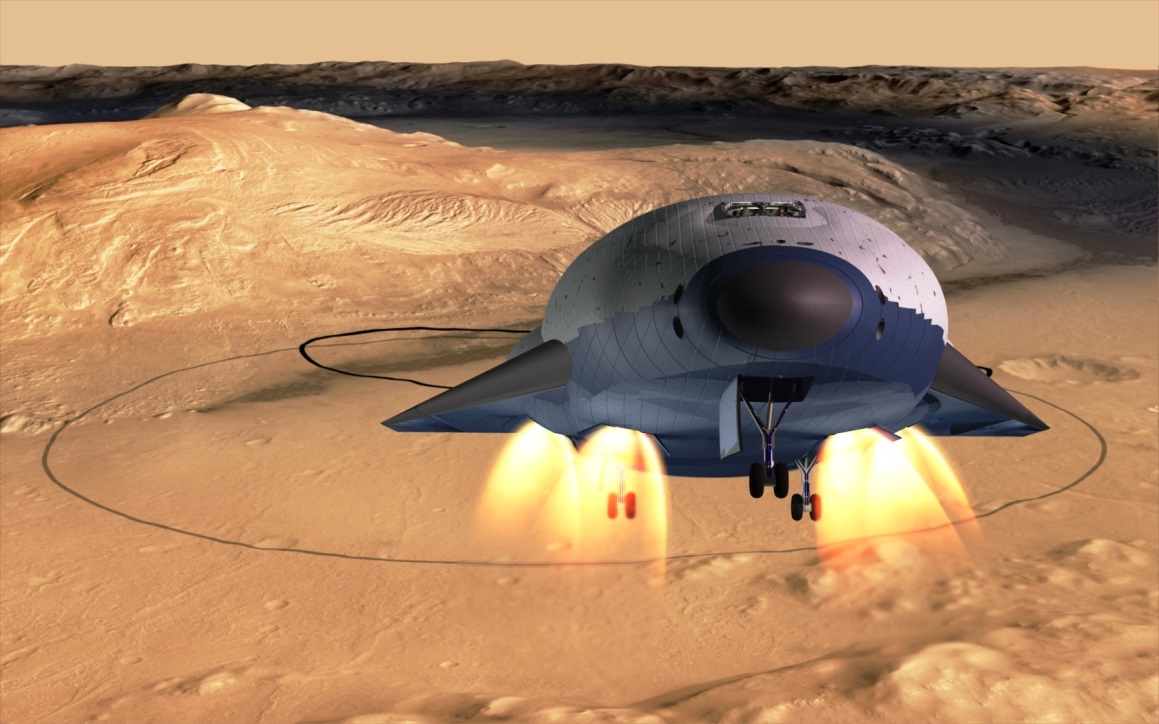5. How to ensure the functions of the colony?
5.1 Vehicles and transport infrastructure – Communication means
Space Traffic (passengers and cargo
Several reasons lead us to imagine that all these traffics will make a stopover in Mars orbit (probably highly elliptical and areosynchronous) and that the interplanetary ships will never land on and take off from the spaceport of the colony, but rather that cargo and passenger shuttles will make round trips between the Martian base and the parking orbit of these ships.
Indeed:
- the interplanetary ships will be massive and very large (on account of the radiators of their nuclear power generators or the panels of their solar generators), and furthermore equipped with electrical engines with very high specific impulse but ridiculously low thrust; for these reasons they will be totally unfit to atmospheric entry and planetary takeoff;
- their important payload in cargo version (150 mT)15 would pose a ballistic coefficient problem (shield size) for an atmospheric braking; if we want protections to be reusable and practically maintenance free, it is necessary to strongly limit the heat flow, and thus split the payload into « batches » of smaller mass (50 mT);
- the propulsion of these devices will be easy to ensure in excellent conditions of operational cost and reliability given the low ΔV required (4.2 km/s, losses included, to reach an orbit of 300 km); O2/H2 engines would do (O2/CH4 for the descent leg); they will present the advantage of being used with propellants produced locally, i.e. from water of the soil and carbon dioxide of the atmosphere (for CH4).
15 It is not unreasonable to imagine that the cargo ships of those days (propelled by high power electric engines) reach a capacity of 150 mT; the flux of 600 mT would correspond to a fleet of 4 shuttle ships (once every 26 months). Note that the exploration missions which are nowadays considered already provide for sending at least three times 50 mT each launch window.
On the basis of a payload equal to 50 mT for the “upward leg” and to 10 mT for the “downward leg” (resp. 25 passengers in both directions for « taxis »), the traffic imagined with Earth (see §4.1) should imply approximately 25 orbital shuttles flights by synodical revolution. Estimating that « commercial » traffic to space project construction sites or « logistics » traffic to Martian orbital stations would represent an equivalent volume, we get a total of 50 flights every 26 months. It is therefore possible to imagine that the spaceport of the colony be dedicated to the service of a fleet (a dozen?) of broad lifting body orbital shuttles in two versions: cargo and passengers. Given the low density of the atmosphere, these vehicles would necessarily be operated with vertical takeoff and landing, and with powered landing, which would waive building (and maintaining) long runways, but would necessarily compel to provide:
- carefully strengthened landing areas (cemented);
- launch pads with jet deflector for takeoffs.
Conveying vessels or heavy equipment between these places and pressurized hangars for maintenance / preparation, far enough (1-2 km) from inhabited areas for safety reasons, must be ensured by carrier vehicles rolling on runways which should be consolidated too. Refueling with cryogenic propellants impose providing “bench foot” tanks that will be fed by tanker trucks commuting to and fro the fluids production center of the colony. The setting will therefore cover an extended ground area, with a network of runways to be kept clean.
Planetary Traffic
On the surface of the planet, the settlers should have the possibility to use different types of vehicles:
- not-pressurized and very sturdy jeeps for traveling within the colony and its immediate surroundings (walking back possible); their structure should be producible on site; a few dozen should be enough, EVA (with spacesuits) having to remain exceptional;
- pressurized rovers (mobile homes) for farther travels (up to 500 km) or travels to satellites sites of the colony i.e. scientific stations, ores mining sites, mineral salts or, possibly, liquid water (artesian wells) extraction sites; each vehicle could have a mass of 10 mT and take a dozen settlers on board; ten or less should be enough, even with an availability rate limited to 50%;
- a few « hoppers », suborbital rockets vehicles, allowing to quickly reach other remote sites, dedicated to scientific research (secondary base) or to resources prospecting;
- a few drones: this long distance travel devices present the advantage of being flexible and relatively easy to implement; but, depending on their size, they may require true runways on account of the low density of the atmosphere; it is therefore unlikely that we’ll go as far as using aircrafts capable of carrying (a) passenger(s) on Mars.

R. Zubrin presenting the Martian drone demonstrator using compressed CO2, developed by his company,
Pioneer Astronautics. (doc. TMS)
Heavy vehicles for transporting and handling, specific to construction sites and mining operations, will have to be added to these general purpose ones.
Communication Means
The colony will need communication means:
- with the Earth and other locations in space (the Moon, asteroids);
- between the various facilities and the mobiles roaming the surface of the planet.
On account of the planet rotation, the presence of several relaying satellites is necessary to provide continuity in space communications. Transmissions between satellites (areostationary) and Earth (or other space destinations) are likely to use laser transmission techniques for overcoming the significant transmission distance handicap. Between surface and satellites, we may keep using radio waves, the episodic development of dust storms prohibiting in any event the use of laser.
Surface communication between the colony, its auxiliary sites (mines, scientific stations), vehicles and residents having EVA, presents specific challenges related firstly to the roundness of the planet (the horizon is closer), and secondly to the absence of ionosphere, these two factors limiting the range of traditional radio means. Again, the use of satellites (stationary or, perhaps, moving) will be required. The implementation of these means will not present any specific difficulties.




excusez moi mais que signifie mT/sol
mT/sol : Tonne du système métrique (les Américains ont une Tonne un peu différente !) par jour martien (de 24h 37 minutes)